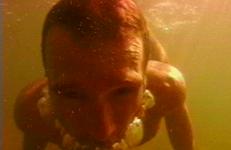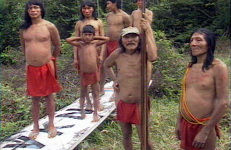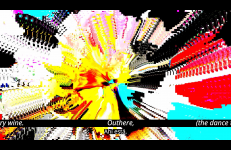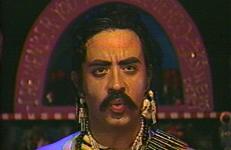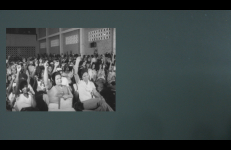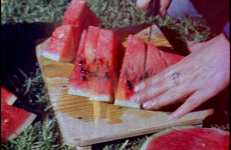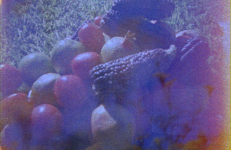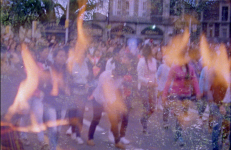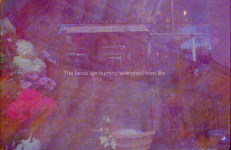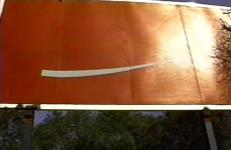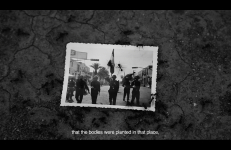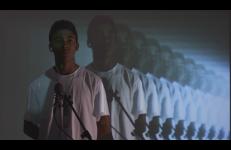A meditation on maritime trade routes, SEA – SHIPPING – SUN is a short film directed by Tiffany Sia (b. Hong Kong) and Yuri Pattison (b. Dublin) shot over the span of two years to render a simulated duration of a day, beginning at twilight and closing at sunset. The film is set against shipping forecasts from archival BBC Radio 4 broadcasts. The sun emerges and disappears, again and again.
Post-colonialism
A meditation on maritime trade routes, SEA – SHIPPING – SUN is a short film directed by Tiffany Sia (b. Hong Kong) and Yuri Pattison (b. Dublin) shot over the span of two years to render a simulated duration of a day, beginning at twilight and closing at sunset. The film is set against shipping forecasts from archival BBC Radio 4 broadcasts. The sun emerges and disappears, again and again.
Sea In The Blood is a personal documentary about living with illness, tracing the relationship of the artist to thalassemia in his sister Nan, and AIDS in his partner Tim. At the core of the piece are two trips. The first is in 1962, when Richard went from Trinidad to England with Nan to see a famous hematologist interested in her unusual case. The second is in 1977 when Richard and Tim made the counterculture pilgrimage from Europe to Asia. The relationship with Tim blossomed, but Nan died before their return.
A remarkable work about the struggle of the Waiãpi tribe, an indigenous people of Brazil, to combat the encroachment of prospectors on their land. Using performative storytelling as well as documentary footage, the tape builds a history of the many negotiations and public performances that the Waiãpi engaged in with the Brazilian government to demarcate and preserve some of their land, and to regain control of their resources.
Directed by Vincent Carelli and Dominique Gallois.
In Waiãpi with English subtitles.
A remarkable work about the struggle of the Waiãpi tribe, an indigenous people of Brazil, to combat the encroachment of prospectors on their land. Using performative storytelling as well as documentary footage, the tape builds a history of the many negotiations and public performances that the Waiãpi engaged in with the Brazilian government to demarcate and preserve some of their land, and to regain control of their resources.
Directed by Vincent Carelli and Dominique Gallois.
In Waiãpi with English subtitles.
"Love at first sight, one night, down at Silverror’s Saloon!" Mickey R Mahoney and jonCates direct Silverror’s Saloon, the next film in the 鬼鎮 (Ghosttown) Glitch Western series of films and games. Written by Emily Mercedes Rich and jonCates, this experimental film queers, glitches, and questions the Western film genre. We encounter characters caught in a glitched cinematic magic moment: a love scene. First dance with a stranger. Home and far from home.
"Love at first sight, one night, down at Silverror’s Saloon!" Mickey R Mahoney and jonCates direct Silverror’s Saloon, the next film in the 鬼鎮 (Ghosttown) Glitch Western series of films and games. Written by Emily Mercedes Rich and jonCates, this experimental film queers, glitches, and questions the Western film genre. We encounter characters caught in a glitched cinematic magic moment: a love scene. First dance with a stranger. Home and far from home.
Fulbeck force-feeds the viewer scores of all-too-familiar Asian female/Caucasian male pairings in Hollywood films, and combines them with contemporary excerpts from best-selling novels, magazines, and dating services. Some Questions For 28 Kisses delves into the causes and purposes of these created images and their relation to interracial dating, ethnic fetishes, race and gender wars, and Hapa identity.
“Leads the viewer on a delightfully rip-roaring jaunt through the Asian Pacific American psyche.”
-- Gerard Lim, Asian Week
In these seven short video performances directed by Isaac Artenstein, Gómez-Peña confronts Mexican-American culture clashes, stereotypes, and the Fourth World (immigrants). Speaking through a bullhorn or on the airwaves of mock-station Radio Latino FM, he broadcasts a message that will not be silenced.
In these seven short video performances directed by Isaac Artenstein, Gómez-Peña confronts Mexican-American culture clashes, stereotypes, and the Fourth World (immigrants). Speaking through a bullhorn or on the airwaves of mock-station Radio Latino FM, he broadcasts a message that will not be silenced.
Spell Reel is an archive of film and audio material from Bissau, Guinea-Bissau. On the verge of complete ruin, the footage testifies to the birth of Guinean cinema as part of the decolonising vision of Amílcar Cabral, the liberation leader who was assassinated in 1973.
Moments of resistance are collapsed and woven together; from documentation of the Indigenous led occupation of Alcatraz, to the reclamation of Cahokia and the repatriation of the ancestors, to one’s reflections on their body as they exist in the world today, these are gestures that meditate on the carceral inception and nature of the reservation system, and where sovereignty and belligerence intersect and diverge.
Sound by Courtney Asztalos
Music by Room Thirteen
Commissioned by the San Jose Museum of Art and the Institute of Arts and Sciences at UC Santa Cruz.
Sunstone tracks Fresnel lenses from their site of production to their exhibition in a museum of lighthouses and navigational devices. It also examines the diverse social contexts in which optics are implicated, contrasting the system of triangular trade that followed the first European arrivals in the ‘New World’ with the political potential seen in Op art in post-revolutionary Cuba.
Sunstone tracks Fresnel lenses from their site of production to their exhibition in a museum of lighthouses and navigational devices. It also examines the diverse social contexts in which optics are implicated, contrasting the system of triangular trade that followed the first European arrivals in the ‘New World’ with the political potential seen in Op art in post-revolutionary Cuba.
An oblique, albeit powerful documentary that examines the current conditions, politics, and economics of South Lebanon. The tape focuses on the social, intellectual, and popular resistance to the Israeli occupation, as well as conceptions of "the land" and culture, and the imperiled identities of the Lebanese people. Simultaneously, the tape self-consciously engages in a critique of the documentary genre and its traditions.
An oblique, albeit powerful documentary that examines the current conditions, politics, and economics of South Lebanon. The tape focuses on the social, intellectual, and popular resistance to the Israeli occupation, as well as conceptions of "the land" and culture, and the imperiled identities of the Lebanese people. Simultaneously, the tape self-consciously engages in a critique of the documentary genre and its traditions.
In 1959, Jean Rouch directed the film La Pyramide Humaine. Situated between fiction and documentary, Rouch’s work presents his attempts to initiate a debate between two groups of students from the Ivory Coast, a white group and a Black group. A precursor to cinéma vérité, this often forgotten film served as the starting point of The Four Chambered Heart.
The Sun Quartet is a solar composition in four movements, a political composition in four natural elements, an audiovisual composition in four bodily mutations: a sun stone where youth blooms in protest, a river overflowing the streets, the burning plain rising in the city. And, finally, the clamor of the people that shook Mexico after the night of September 26, 2014. The disappearance of 43 students from Ayotzinapa opened a breach in the Mexican political body.
The Sun Quartet is a solar composition in four movements, a political composition in four natural elements, an audiovisual composition in four bodily mutations: a sun stone where youth blooms in protest, a river overflowing the streets, the burning plain rising in the city. And, finally, the clamor of the people that shook Mexico after the night of September 26, 2014. The disappearance of 43 students from Ayotzinapa opened a breach in the Mexican political body.
The Sun Quartet is a solar composition in four movements, a political composition in four natural elements, an audiovisual composition in four bodily mutations: a sun stone where youth blooms in protest, a river overflowing the streets, the burning plain rising in the city. And, finally, the clamor of the people that shook Mexico after the night of September 26, 2014. The disappearance of 43 students from Ayotzinapa opened a breach in the Mexican political body.
The Sun Quartet is a solar composition in four movements, a political composition in four natural elements, an audiovisual composition in four bodily mutations: a sun stone where youth blooms in protest, a river overflowing the streets, the burning plain rising in the city. And, finally, the clamor of the people that shook Mexico after the night of September 26, 2014. The disappearance of 43 students from Ayotzinapa opened a breach in the Mexican political body.
This Is Not Beirut is a personal project that examines the use and production of images and representations of Lebanon and Beirut, both in the West and in Lebanon itself. It also records Salloum’s interactions and experiences while working in Lebanon, focusing on this representational process by a Westernized, foreign-born Lebanese mediator with cultural connections to and baggage from both the West and Lebanon.
I live in the Hudson Valley near the Hudson River. Historically, Muhheakunnuk, a river that runs both ways was a waterway for the colonization of North America. This film combines old footage I shot of the river in winter when the ice flowed with a live video/audio synthesizer performance as a meditation on settler colonialism and its ecosystem.
— Les LeVeque
Radio reports analyze staged photographs we do not see, showing the victims of a mass murder committed by Mexican soldiers. The politicization of the film accounts for the duality between framing and mis-framing, and also shows the overflowing character of a process of transit.
Transmission from the Liberated Zones is an experiment which brings together Swedish statements and documents, accessed and presented by a boy through a low-fidelity feedback channel — an optical dimension created to move through time, and between tepid and tropic encounters.





